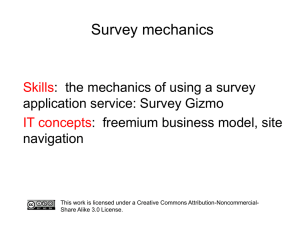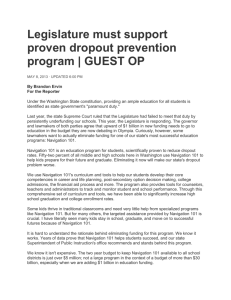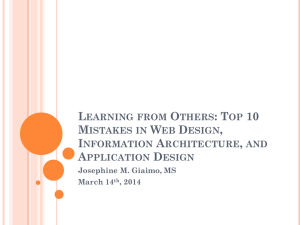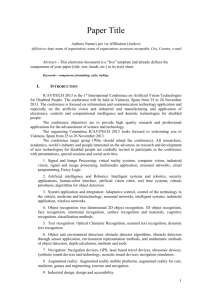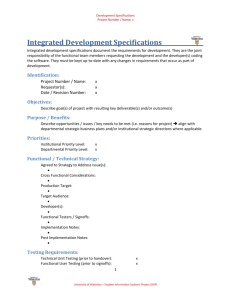Navigation 101 Curriculum-FY 2 - Office of Superintendent of Public
advertisement
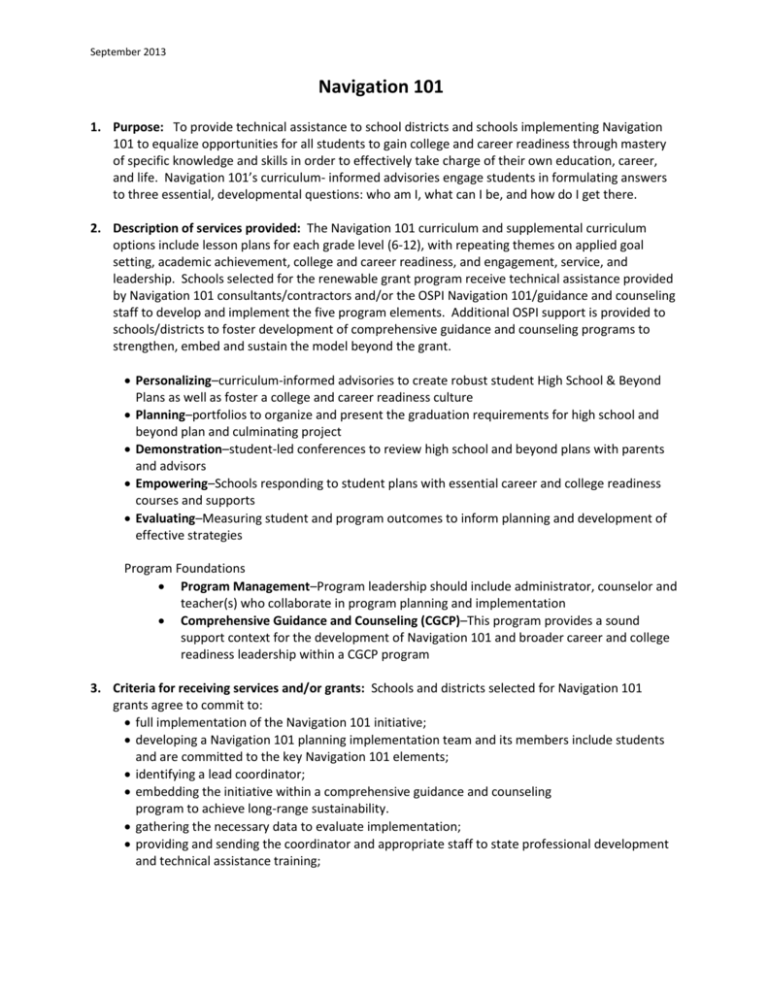
September 2013 Navigation 101 1. Purpose: To provide technical assistance to school districts and schools implementing Navigation 101 to equalize opportunities for all students to gain college and career readiness through mastery of specific knowledge and skills in order to effectively take charge of their own education, career, and life. Navigation 101’s curriculum- informed advisories engage students in formulating answers to three essential, developmental questions: who am I, what can I be, and how do I get there. 2. Description of services provided: The Navigation 101 curriculum and supplemental curriculum options include lesson plans for each grade level (6-12), with repeating themes on applied goal setting, academic achievement, college and career readiness, and engagement, service, and leadership. Schools selected for the renewable grant program receive technical assistance provided by Navigation 101 consultants/contractors and/or the OSPI Navigation 101/guidance and counseling staff to develop and implement the five program elements. Additional OSPI support is provided to schools/districts to foster development of comprehensive guidance and counseling programs to strengthen, embed and sustain the model beyond the grant. Personalizing–curriculum-informed advisories to create robust student High School & Beyond Plans as well as foster a college and career readiness culture Planning–portfolios to organize and present the graduation requirements for high school and beyond plan and culminating project Demonstration–student-led conferences to review high school and beyond plans with parents and advisors Empowering–Schools responding to student plans with essential career and college readiness courses and supports Evaluating–Measuring student and program outcomes to inform planning and development of effective strategies Program Foundations Program Management–Program leadership should include administrator, counselor and teacher(s) who collaborate in program planning and implementation Comprehensive Guidance and Counseling (CGCP)–This program provides a sound support context for the development of Navigation 101 and broader career and college readiness leadership within a CGCP program 3. Criteria for receiving services and/or grants: Schools and districts selected for Navigation 101 grants agree to commit to: full implementation of the Navigation 101 initiative; developing a Navigation 101 planning implementation team and its members include students and are committed to the key Navigation 101 elements; identifying a lead coordinator; embedding the initiative within a comprehensive guidance and counseling program to achieve long-range sustainability. gathering the necessary data to evaluate implementation; providing and sending the coordinator and appropriate staff to state professional development and technical assistance training; negotiating with the representative bargaining unit(s) on any proposed changes that might affect the current wages, hours, and working conditions; and responding to periodic surveys. o fully participate in a school improvement planning or systems change process to integrate the program within their school programs. 4. Beneficiaries in 2012-13 School Year: # of School Districts: # of Schools: # of Students: 5. FY 13 Funding: 85 148 68,698 State Appropriation: $2,808 million Other funding sources–College Spark College Readiness Initiative (Navigation 101 / AVID) Administrative $225,000 Navigation 101 School Grants $510,000 FTEs 3.0 FTEs 6. Are Federal or other funds contingent on state funding? If yes, explain. Yes. If state funds are not matched with the College Spark WA grant, Navigation 101 will not be eligible to receive the College Spark WA grant. 7. First year funded: Fiscal year 2007 8. State funding since inception: FY13 FY12 FY 11 FY 10 FY 09 FY 08 FY 07 $2.808 million $2.808 million $2.898 million $3.219 million $3.22 million $3.22 million $3.9 million 9. Number of beneficiaries (e.g., schools, students, districts) since inception: Fiscal Year # of schools # of districts FY13 FY12 FY11 FY 10 FY 09 FY 08 FY 07 148 152 137 132 187 210 136 85 73 65 68 99 93 79 # of students served 68,698 74,794 69,387 68,331 102,480 129,038 107,617 $$Amount of Grant per school $5,000 $7,500 $5,000 - $10,000 $5,000 - $10,000 $10,000 - $15,000 $10,000 - $15,000 $10,000 - $15,000 Comprehensive Guidance & Counseling Program (CGCP)/Navigation 101 Grants Fiscal Year # of schools # of districts FY13 10 7 # of students served 6,203 $$Amount of Grant per school $3,000 Starting in 2011, the curriculum and electronic portfolio resources became available to all middle and high schools without utilizing a state grant. Through the contract with Envictus for Navigation101.com the number of schools signed up to use the Navigation 101 curriculum increased from 19% in 2011 to 52% in 2013, which amounted to 435 middle and high schools in our state. The Navigation 101 proviso supported 464,280 students in 435 schools using Navigation 101.com, which contained college and career readiness classroom and online lessons with electronic tools for the High School and Beyond Plan/Portfolio. Fiscal Year FY13 FY 12 FY 11 # of schools 435 351 170 # of students served 255,680 210,600 92,800 10. Average and range of funding per beneficiary, 2009-13 school year: The average amount of funding received per school was $7,500, with a school range of $3,000 to $10,000 under the proviso grant program. 11. Programmatic changes since inception: Navigation 101 has designed and updated lessons that allow students to annually update their High School and Beyond Plan (a graduation requirement) along with integrating the Program of Study, providing a combined document which records their progress in all areas. Together the High School and Beyond Plan and Program of Study assure that students are on track for high school graduation and are college and career ready. OSPI has created lessons for nontraditional, high demand, and underrepresented occupations especially in the high demand areas of health care, construction trades, and information technology in Spring, 2009. Navigation 101 (guidance curriculum) lessons have been revised to more fully reflect career and technical education opportunities. Additional upgrades of Navigation 101 middle and high school curriculum were made in Spring, 2010, under contract with a social entrepreneurial company, Envictus. OSPI contracted with Envictus to provide Navigation 101 Online, a Web-based individualized instruction curriculum with strong management tools in some core career and college readiness competencies. This system afforded schools with a means to measure some career and college readiness outcomes for students, empowering the school to be able to identify and respond to students who have not achieved “readiness.” OSPI contracted with Envictus in 2009-2011 to provide Change Management Services to 95 of the state-funded grantees in addition to the 19 schools funded via the College Spark Foundation grant. These services provided a consultant to the grantees to enhance program implementation support and professional development to achieve higher levels of program fidelity. OSPI evaluated the change management model via a separate evaluation contract with The BERC Group. OSPI continues to work to create a statewide “best practice” guidance and counseling program framework to support all WA schools to more effectively integrate guidance curriculum and Navigation 101 within broader individual student and school career and college readiness outcomes, aligning with legislative intent for school counselors (RCW28A.410.043) and the State Board of Education related to guidance and counseling, High School and Beyond Plans, as well as state graduation requirements (November 9-10, 2010, SBE meeting). 12. Evaluations of program/major findings: The third party evaluation of Navigation 101 by the BERC Group in 2012 reported the following findings: 1. There has been a steady increase in the percentage of students from Navigation 101 funded schools enrolling in Gatekeeper courses. Algebra or higher in middle school–23.9% in 2007–08 27.6% in 2011–12 Advanced Math in HS–60.5% in 2007–08 63.4% in 2011–12 Chemistry–41.4% in 2007–08 47.9% in 2011–12 2. Many of our multi-year Navigation 101 grantees have seen significant increases in on-time graduation rates. For example Grandview High school, with a 100% free/reduced lunch participation rate has increased from 80.4% in 2007-08 to 91% in 2010-11. 3. All students attending Navigation 101 schools increasingly participate in annual student led conferences. 78% in 2009–10 85% in 2011–12. 13. Major challenges faced by the program: Navigation 101 has grown over the past three years and this growth has presented several challenges: Sustainability: Systems change research identifies approximately three years of active and effective development necessary for a school to adopt, integrate, and sustain a school-wide initiative such as Navigation 101. Grantee eligibility beyond three years will be considered only after priority new or continuing applicants are considered for participation. Coaching and Support: The support network for coaching, mentoring, and professional development will need to be refined and expanded as more schools start Navigation 101 or similar career and college readiness programs. This development will be fully informed by evidence-based practice standards including District /School improvement “best practice” processes, comprehensive guidance and counseling program development, as well as other proven approaches. Lesson Development: Navigation 101 development is responding to emerging evidence that informs continued development of grade level lessons. Current development is especially targeting diverse and underrepresented student populations, recent changes in graduation requirements, evolving college and career readiness standards, as well as for increasing student awareness of programs of study especially in high demand fields. To insure that all WA schools can access effective career and college readiness curriculum, program staff will continue to collaborate with our College Spark partner as well as other state agencies to develop, align, adopt, or adapt additional curriculum. Additional efforts are underway with the University of Washington, Social Development Research Group, through funding from the Raikes Foundation, to identify critical middle school outcomes, around which we can develop lessons with strong measurable outcomes, preparing students for successful transition to high school. Data: Research continues to inform the various program elements, the need to review and refine our metrics is critical to program development. These are important factors we are seeking to consider as we refine, collect, and analyze our data, especially the longitudinal data on graduation rates and pre-college course work under our contract with The BERC Group. This information will be utilized to more effectively engage grantees specific to program implementation goals. 14. Future opportunities: Navigation 101 is a “best practice” model that represents part of a comprehensive school guidance and counseling model. The continuing development of a guidance and counseling framework, informed by previous legislative and State Board of Education actions will guide grantees in their work to insure that their guidance efforts are integrated within their school program, and are effective with all students. Professional development through regional trainings and workshops has given schools support and resources to increase sustainable programs. Navigation 101s’ (guidance curriculum and individual planning) ongoing partnership with College Spark will continue to foster development to insure that program elements are effective with diverse student populations, thereby strengthening career and college-readiness, resulting in fewer students needing developmental courses in college and technical schools. Lesson development for career and college readiness has continued to be updated and aligned with Common Core State Standards. The College Spark grant and State proviso dollars continue to make significant progress in providing grantees as well as OSPI program staff with usable career and college readiness data to inform local and state program planning. We will continue to strengthen our evaluation model in partnership with our evaluation contractor (The BERC Group) to insure most effective and efficient use of proviso dollars. 15. Statutory and/or Budget language: Budget proviso: 2ESHB 1087, Sec 501 (2) (c) (iii) $ 2.808 million of the general fund-state appropriation for FY 12 and $2.808 million of the general fund-state appropriation for the FY13 are provided solely for the dissemination of the Navigation 101 program materials to all districts. Funding has supported evidence-based planning and sustainability strategies for optimizing the impact of Navigation 101 on student career and college readiness. Such funding shall support grants to a minimum of 100 school districts each year (maximum three years) based on program implementation needs and readiness to benefit. The implementation grants are awarded to a cross-section of school districts reflecting a balance of geographic and demographic characteristics. Within the amounts provided, the office of the superintendent of public instruction created a Navigation 101 accountability model to analyze the impact of the program. 16. Other relevant information: College Spark analyzed 25 college preparation programs and selected to partner with Washington State’s Navigation 101 along with Advancement Via Individual Determination (AVID) to promote college readiness for low income students in 19 grantee schools in seven districts with a $ 9.5 million eight-year grant. This initiative is designed to closely work with this group of grantees to fully implement and measure program effectiveness, as well as to increase effectiveness with underrepresented student populations. 17. Contracts in FY13 a. BERC Group–$50,000 for Program Evaluation b. Envictus Corporation–$1,500,000 for online lessons, resources, tools and program support 18. Attachments and Resources: a. Grantee list from 2006 to 2013 (attached) b. OSPI Web site link at http://www.k12.wa.us/SecondaryEducation/CareerCollegeReadiness/default.aspx c. Charting Our Course White Paper on using the Navigation 101 framework to implement a Comprehensive Guidance and Counseling program at http://www.k12.wa.us/SecondaryEducation/GuidanceCounseling/pubdocs/nav-counselingpaper2008.pdf d. College Spark grant announcement http://www.collegespark.org/downloads/PR/OPSI%20Press%20Release%208.08.pdf e. High Skill, High Wages: 2008–2018 The State Strategic Plan for Workforce Development http://www.wtb.wa.gov/Documents/HSHW2008.pdf

